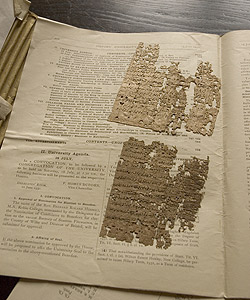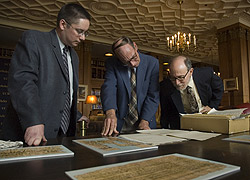Berkeleyan
Egyptian finds arrive on campus a century after their discovery
Some of 'our' papyri were stored for decades at Oxford; still more remain in Boston
![]()
| 26 October 2005
 Fragments of Egyptian papyrus excavated at the behest of Phoebe Appleton Hearst were recently shipped to campus from England, cushioned in back issues of the Oxford University Gazette. Future scholars, take note: the edition shown here is dated 15 July 1931 - old, certainly, but no Tebtunis.(Steve McConnell photos) |
In the winter of 1899-1900, British archaeologists Bernard Grenfell and Arthur Hunt excavated the temple, town, and cemetery of Tebtunis, Egypt, at the behest of University of California benefactress Phoebe Apperson Hearst. After uncovering a treasure trove of papyri and artifacts, they brought them to their home base at Oxford University for study and publication of selected pieces.
After the first two volumes were published, further work was slowed by the illness and death of the two scholars, so the papyri remained at Oxford for longer than expected, said papyrologist Todd Hickey, curator of the Center for Tebtunis Papyri at the Bancroft Library.
Although much of the material was eventually sent to the campus in the late 1930s (and another box arrived in the 1950s), additional containers remained overlooked, Hickey said. But a couple of years ago he noted that an inventory of the numbering applied by Grenfell and Hunt to many pieces in the center's collection (which totals more than 30,000 items) showed numerous gaps in the sequence. The newly hired curator also noted that a research paper published by a University of Toronto scholar cited pieces of papyri that he studied at Oxford; they contained excavation numbers that identified them as part of Berkeley's Tebtunis collection. "So we had a pretty good idea there was material at Oxford that belonged to us," Hickey said.
Next, Donald Mastronarde, professor of classics and director of the Tebtunis Center, wrote to the chief of Oxford's Oxyrhynchus Center, which houses an extensive papyri collection assembled from a community north of Tebtunis. Oxford acknowledged possession of some pieces of the Tebtunis papyri collection, said Hickey, and serious efforts to bring them home began.
 Todd Hickey, curator of the Center for Tebtunis Papyri; Anthony Bliss, curator of rare books and manuscripts at the Bancroft Library; and Donald Mastronarde, director of the Tebtunis center, examined papyri recently returned from Oxford at an Oct. 18 event in Morrison Library. |
"There remain unknown and potentially blockbuster items in these boxes of mummy cartonnage," said Hickey. "Often you really don't know what you have until you give a text your time, until you have begun the difficult process of reading in earnest." Whatever is found, he added, Berkeley students and scholars will benefit by having still more papyri to review and study.
'A lack of transparency . . .'
In a ceremony held last week in the Morrison Library within Doe Library, Mastronarde noted that while Hearst had hired the German scholar George Reisner as her agent to help with the Egyptian and Greco-Roman civilization materials from Tebtunis, he ended his employment with her in 1905 and went to work for the Boston Museum of Fine Arts, where some of the Tebtunis documentary materials and four Middle Kingdom papyrus rolls remain to this day. Referring to a "lack of transparency and . cooperation on the part of Reisner and some of his successors" at that museum, Mastronarde expressed the hope that "the good example set by Oxford in the delivery of Mrs. Hearst's Tebtunis papyri may have some effect in persuading others to show a similar sense of cooperation."
Roger Bagnall, the 92nd Sather Professor of Classical Literature at Berkeley (an annual appointment) and a professor of classics and history at Columbia University, said the recently transferred pieces of papyri appear relatively complete and in even better condition than some of the rest of the collection. A leader in the field of papyrology, Bagnall said the items seem to push the date back even earlier for some of the materials found in Tebtunis, a village inhabited more than 1,700 years ago. The materials also will "connect some of the dots" between the Tebtunis Center materials and those obtained from the Egyptian village by clandestine means and housed in other institutions scattered around the world, Bagnall said.
In addition, he said, studying the new documents should help shed new light on the archaeological processes used by Grenfell and Hunt in excavating what he called "one of the great finds in the field of papyrology."
Some of the findings made from the Tebtunis collection will be explored in an international conference, "Papyrology: New Directions in a New Generation," to be held on campus Nov. 11 and 12.
Information about the Center for Tebtunis Papyri is available online at tebtunis.berkeley.edu.

